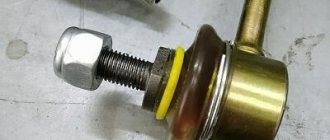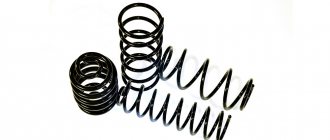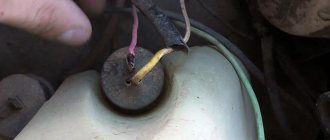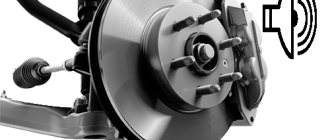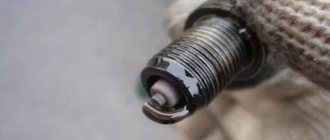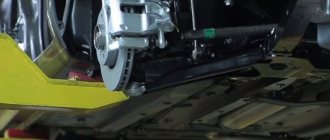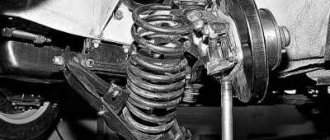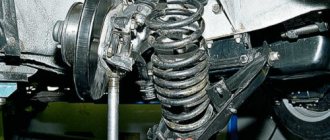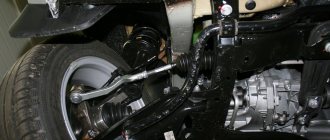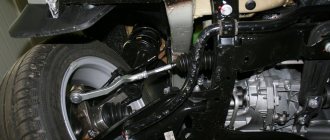09 February 2016 Lada.Online 208 049 81
The front and rear suspension of Vesta differs significantly from the one that AVTOVAZ used on Grant, Priora, Kalina, etc. All the reviews tell us that the new chassis design is better than before. However, during the first months of operation, the owners began to notice extraneous noises (knocks, creaks, rattles, crunches) in the front and rear suspensions of Vesta, which occur when driving over speed bumps or other road irregularities...
The most common shortcomings of the Lada Vesta car suspension
Drivers' complaints are caused by extraneous noises, squeaks and crunching sounds from the car's chassis. Most often they occur in the front part of the car, but many also complain about knocking from the rear suspension elements. The most common causes of these sounds are:
- Noise from front stabilizer struts.
Owners of the first Vesta cars began to notice extraneous sounds from the front suspension after several thousand kilometers. The reason for this turned out to be poor-quality stabilizer links. After considering consumer complaints, the manufacturer ordered that these parts be replaced free of charge in case of complaints.
- Rear shock absorbers knocking.
The rear struts knock when driving on rough roads. This is due to the fact that there is no insulating gasket between the shock absorber and the upper support, and metal hits metal when hitting an obstacle. The official service does not undertake to eliminate this deficiency, since it does not affect the driving performance of the car.
Under the hood
The main problems: chafing pipes, rattling engine lining, have already been fixed in new batches. In mine, I filed down the notch so that the breather would not rub. The engine mount is also knocking. The treatment is simple - spray with silicone grease, and temporarily listen to silence or change the pillow. The manual transmission is not quiet, and the robot's actuator dries out lubricant, and it begins to creak when the gas is pressed, especially in the heat.
The canister valve still clicks loudly - it’s better not to touch it, it won’t get any quieter. The lion's share of knocks on my Lada Vesta comes from the resonator and plastic pipe.
For the test, a piece of material was inserted for gluing sound insulation. You cannot completely remove the resonator - it is needed to dampen the sound. Although some people throw it away. It knocks because of the metal mounting bracket or pipe. It is frayed or installed loosely. The dealer contacted the factory - this is not a warranty issue. A new resonator with a pipe assembly in the cabin costs 1,500 rubles. They advised to wrap it with electrical tape. Draw your own conclusions about AvtoVAZ’s attitude towards consumers.
How to identify the cause of the noise yourself?
If the machine is under warranty, if you suspect any malfunction, you must contact your nearest service center. If the warranty has expired or this is not possible, you can try to determine the cause of the unpleasant noise yourself.
To do this, you need to hang the car wheels and move them in different directions. When conducting diagnostics, the following conclusions can be drawn:
- If there is play when the brake pedal is not pressed, then the wheel bearing needs to be replaced;
- If there is something wrong with the suspension, the play will not go away when you press the brake pedal;
- A ball joint defect can be suspected if the play occurs in the vertical plane. This sensation can also occur if the stand is poorly secured;
- Wobbling in the horizontal plane most often indicates a faulty tie rod end.
Having identified the causes of a creaking or rattling noise, it is necessary to eliminate it as soon as possible by replacing damaged parts. It is better to do this at a service station, where specialists will carry out reliable diagnostics and carry out repair work.
Loose wheel bolts
The situation when the fastening bolts of one or several wheels have become loose is typical not only for Lada Vesta, but occurs frequently. There can be many reasons - from inattention during tire fitting to an unsuccessful attempt to steal a wheel.
If a knocking sound occurs while driving, the first step is to perform the most accessible action - stop the car and check the tightness of the wheel bolts, since a tire that falls off while turning can cause the car to roll over with unpredictable consequences. In this case, diagnostics is inseparable from troubleshooting.
After tightening the bolts or making sure that the reason for the knocking is not their tightening, you can continue driving. If the problem is not solved, you should not put off diagnosis for a long time. In order not to aggravate the situation when one malfunction causes another, it is strongly recommended to contact an authorized dealer as soon as possible for qualified diagnosis and elimination of the causes of knocking or other abnormal suspension noises performed on a car raised by a lift.
Independent repair of a car before the expiration of the warranty period may be classified by the dealer as a violation of contractual obligations by the consumer and become grounds for premature termination of warranty service.
Front suspension. What might be a concern?
- Wheel bearings.
Wheel bearing noise can be detected by ear even by a less experienced driver. It howls and rustles when moving and, gradually increasing, begins to drown out all other noises in the cabin. To make sure that it is the bearing that is making noise, you need to turn the steering wheel a little when driving at speeds above 60 km/h. If the rumble appears in one steering position and stops in another, it means the bearing has definitely failed. You can also check this by lifting the car wheel and spinning it. If you hear a characteristic rustling sound, it means the bearing needs to be replaced.
- Stabilizer's pole.
Stabilizer links are the most vulnerable part of the suspension. Due to the poor quality of roads, they often fail and begin to produce a slight but constant noise from under the bottom of the car. You can determine if the struts are broken by resting the lever on the subframe and shaking the stabilizer. If during these actions a knock is heard and play is felt, it means that the stabilizer links are out of order.
These parts are usually replaced in pairs, and you can do it yourself. To do this, you need to hang the front wheels of the car, and using a 16 wrench, unscrew the hinge nuts, while holding them with a 5 hex wrench on the back side so that the hinges do not turn.
- Spherical bearing
The sound of a broken ball joint can be difficult to distinguish from other suspension noises. You can check the play of this unit by moving the suspended wheel in a horizontal plane. If the fault cannot be determined, you can insert a pry bar between the subframe and the lever and press on the resulting stop. This is the easiest way to identify a loose ball pore.
At the service center, the ball joint is replaced along with the lever and silent blocks. But these parts also exist for sale as a separate unit.
Replacing a ball is not an easy operation, so you can tackle it yourself only if you have the necessary tools and metalworking skills.
- Shock absorber.
Many drivers complain about the knocking of Lada Vesta shock absorbers, but their design itself eliminates this possibility. The telescopic strut consists of two cylinders that dampen vibrations while moving on uneven roads. When they break down, the car begins to “sit down”, the road holding is poor, all the unevenness and bumps become clearly noticeable, and the steering deteriorates. In this case, the outflow of liquid or gas from one cylinder to another is disrupted, and the shock absorber rod begins to make characteristic sounds that resemble knocking.
Visually, a breakdown of the oil shock absorber can be determined by drips on the casing, in the presence of which the part must be replaced immediately. You can also rock the car, focusing on the hood. Under normal conditions, after the impact ceases, the machine should swing once and stop moving. If this does not happen, the racks do not absorb as expected.
- Upper rack support
The upper mount of the front shock absorber contains a support bearing that can knock and howl when driving. You can identify a malfunction of this unit in the following way: swing the car in a vertical plane and put your hand on the support. If a part malfunctions, rattling and humming will be felt.
Another method requires completely dismantling the rack. This check can be done simultaneously with replacing the front shock absorbers. After removing the steering knuckle, you need to rotate the strut together with the spring in a circle. The crunching and grinding sound in the upper part of the assembly that occurs during this indicates that the support is faulty.
Like shock absorbers, it is advisable to change the upper supports at the station, since the process of dismantling and installing them is quite complicated.
Top 4. CTR CLMZ-30
Rating (2020): 4.39
- Nomination
Most popular product Stabilizer link, suitable and recommended for cars of more than 10 brands. The brand has enjoyed constant popularity for many years and often takes part in independent tests in various specialized publications. - Characteristics Average price: 1080 rub.
This stabilizer link has the greatest compatibility. But the point here is not that the design has some kind of original form factor, it’s just that it was tested on all these brands. It is not surprising, since the brand is in demand and is one of the leading players in the market. Its shock absorbers, stabilizers and brake modules are constantly included in reviews of such publications as Behind the Wheel and Auto Review. The brand itself also carefully monitors its reputation, but we note that this does not always work out. There will still be defects, and the number of fakes on the market exceeds all imaginable indicators. True, the company tries in every possible way to protect itself from counterfeiting, but scammers do not skimp on copying security measures.
Rear suspension knocking and noise
Unpleasant knocks from the rear suspension occur less often than from the front, but sometimes they also bother owners of Vesta cars.
The most common phenomena that can cause noise are:
- Rear beam silent blocks;
- Faulty rear shock absorber mounts or shock absorbers themselves;
- Lack of soundproofing gasket between the shock absorber and the upper support.
The first two problems are eliminated by replacing failed components. The knock of the strut on the support does not affect the driving performance and is not a breakdown, but a factory defect of Vesta. You can eliminate it by placing a purchased or self-made gasket between the parts that are closing and emitting an irritating sound.
Problematic steering mechanism
Experienced car owners, those who drive frequently, may notice that the sound comes not only from the support struts, shock absorbers, levers, but most likely from the steering. Most often, the steering rack suffers; the sound is very similar to a knock in the shock absorbers, so identifying the fault is quite difficult. Also, in addition to making sure that the problem is with the rack, the vibration on the steering wheel that comes from driving while driving will help.
The sound that appears is associated with the interaction of the rack itself and the gear moving along it. Gradually, the gap most likely increases, and the intensity increases accordingly. This occurs due to the significant development of elements in the mating parts of the pair itself. To check for such a malfunction, you can lift one of the sides of the machine and shake the rods; if you feel a slight play, then most likely the dull sound is produced by worn bushings. These problems are not critical if they are noticed in time and all necessary repair work is carried out.
In addition, the steering joint can also be the culprit for the appearance of all kinds of noise. When diagnosing this element, you need to have a partner on hand who will sharply rotate the steering wheel at small intervals, and you will be required to secure the body, pin and hinge. And the resulting slight play, which will be immediately felt and will cause extraneous sound. Repairs will cost much less than restoring the entire suspension.
Owner reviews about the Lada Vesta suspension
| Positive | Negative |
| The rubber blocks in the suspension squeaked in the rain from the very first day of purchase. I didn't pay attention when during the maintenance they asked if any suspension sounds were bothering me. I voiced my problem and they replaced my stabilizer bars for free. | I think the car is not worth the money. I chose between Polo, Solaris and Vesta. I took Vesta because it was cheaper, and the quality, as it seemed to me during the test drive, was the same. But, unfortunately, this is not the case. I was disappointed after the first 10 thousand mileage. The automatic transmission works terribly and the suspension rattles like an old Lada. |
| I have owned a Vesta SV Cross car for about a year now. I took it in a minimal configuration, but I’m happy with everything. The cross-country ability is really good, even on our broken country roads. The suspension doesn't make itself felt at all, I haven't changed anything in all this time, and nothing creaks. | In addition to the creaks of the interior and peeling chrome on the decorative elements, the suspension was terribly disappointing. The defective stabilizers were replaced under warranty. But after a while they began to creak again. The rear shock absorbers also make a lot of noise. And in general, the whole suspension is kind of flimsy, as if you were driving a Chinese car! |
| I drove about 3000 km on my Vesta. I go mainly to the dacha and fishing, so the load is almost always full. The suspension behaves decently, at least I didn’t notice any knocks, and during the technical inspection they said everything was fine. | 3 months after the purchase the front began to rattle. And soon the rear shock absorbers. I went to the service several times - they didn’t care about my problems! In the end they agreed to change the racks, but they were not in stock. I'm waiting for the third week, I'm already tired of visiting them! I don’t recommend buying Vesta at all, it’s better to take Rio and not know grief! |
| Overall I like the car. Beautiful, comfortable, roomy and most importantly - inexpensive. What worries me a little is that the steering wheel doesn't respond well when turning at high speeds. This is probably due to the high ground clearance. There are no comments on the suspension, it works properly, no noise was noticed. | In addition to the fact that the front windows were quickly scratched by poor-quality seals, after six months of use on the Vesta, clear knocking noises from the rear suspension began to be heard. It turns out that eliminating noise is not the responsibility of the warranty service, so I had to finish it myself. I bought special fluoroplastic spacers on the market. Installing them is not difficult, but why waste time, especially since the car is completely new? |
Let's summarize
As you can see, the work is simple and accessible even to a beginner; it is important to first understand the stabilizer circuit and understand how to fix the malfunction. Factory elements are made of rubber
To replace it, it is better to buy polyurethane elements; their service life is up to 4 times longer compared to rubber parts. Elements made of polyurethane are resistant to chemicals, water, and can withstand high loads. In addition, they maintain operational parameters at sub-zero temperatures, which ensures vehicle stability and controllability on the roads in winter.
You can also watch the procedure for replacing stabilizer bushings on a Lada Vesta in this video:
Conclusion
- The suspension of the Lada Vesta car is of good quality, but has some shortcomings.
- One of the most common reasons for contacting warranty service is knocking and noise from the front and rear suspension.
- Most often, the front stabilizers fail, as well as the rear shock absorbers, which begin to work noisily over time.
- It is possible to make a diagnosis yourself, but the result will not always be unambiguous. If this is possible, it is better to contact a service station to professionally diagnose and, if necessary, repair the car.
Analogs of stabilizer struts. Dimensions of components
| Catalog number/dimensions | Price in rubles |
| Toyota Rav4 (48820-42020), length 285 mm | From 2500 |
| Non-original from CTR (CLT50) | From 650 / piece |
| Renault, SASIC, SIDEM, LEMFORDER, length 275 mm | From 400 |
| Alfa/Fiat/Lancia 46413122 | From 370 |
| MONROE: L15600 | From 380 |
| Multipla, Lybra | From 350 |
| Kia Rio (548132K100) | From 370 |
| Stabilizer bracket, bracket (548141G000) | From 250 |
*prices are current as of 03/06/2019.
Replacement Guide
In order to change the stabilizer link, you need a lift or two jacks. Unloading the racks is mandatory, and this is only possible with the car raised.
Carefully! You cannot replace an element if it is in a stressed state. Hanging the front wheels allows you to fulfill this condition.
It will not be possible to replace the stabilizer struts without two stumps or bricks, an inspection hole, a 16-size socket wrench, a 14-size wrench, a 15-size wheel wrench, and WD-40. A key for 14 and 15 is required to install a new pair. Different models may require different keys.
First of all, it is necessary to install wheel chocks under the rear wheels. Next, remove the decorative caps on standard alloy wheels. To do this, you need to use a screwdriver.
After this, the bolts are unscrewed, but everything is done while the car is on the ground. Jacks must be placed according to special marks available on the Vesta thresholds. Using a rolling hydraulic jack will greatly simplify the task.
After removing the front wheel, the part will become visible. The first step is to unscrew the top hinge. Using a VD will greatly simplify the task. Next, take a 60 TORX with a 16 wrench. Using the wrench, you need to remove the nut that secures the strut to the shock absorber. In this case, it is necessary to hold the hinge rod. The presence of corrosion can interfere with this process, so we again use VD.
Next, you need to pull the finger out of the mounting hole. You should start with the bottom hinge. Some difficulties may arise due to the fact that the element is located in a hard-to-reach place. It will be much faster if you do all the work from the pit. To get the entire old part, you need to pull out the hinge pin. A new one is installed in place of the old stabilizer link. Everything is put together in reverse order.
Oil getting into the coolant
There is a decrease in the oil level in the engine, an oil film appears in the expansion tank, and the color of the coolant changes from gray to dark brown.
To check, remove the cylinder head, fill the cooling jacket of the cylinder block with water and supply compressed air to the vertical oil channel of the cylinder block (near the hole for bolt 5, see Fig. 22).
If air bubbles are observed in the water filling the cooling jacket, then the cause of the malfunction is cavities or cracks in the jumpers between the oil line and the cooling jacket of the cylinder block. In this case, the cylinder block must be replaced.
If the oil passages in the cylinder block are sealed, then oil may be leaking into the coolant from the oil passages in the cylinder head. In this case, it is necessary to check the tightness of the cylinder head (see the chapter “Main malfunctions of the gas distribution mechanism”).
Service life of shock absorbers of various types
Car racks, depending on the internal structure and principle of operation, are divided into three types.
- Oil - operate due to the flow of working fluid from the cavity above the piston into the cavity below it. The simplest and cheapest type. Serves an average of 60 thousand km.
- Gas - have two sections in one cylinder, separated by a freely moving piston: gas and oil. The gas pump dumps dynamic loads and pushes the rod out of the cylinder. Oil is used to dampen car vibrations. Despite the increased number of moving parts and the addition of a gaseous working phase to the design, this type of shock absorber struts is considered more durable: the average service life is about 80 thousand km.
- Gas - oil. They consist of two cylinders nested one inside the other. The outer one is designed to store gas, the inner one is for moving the piston in an oil environment. This design is more complex and expensive to manufacture, but in terms of comfort, gas-oil shock absorbers are superior to conventional gas shock absorbers. Such racks also last about 80 thousand km.
